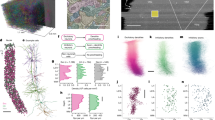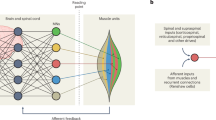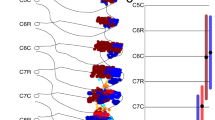Abstract
B. RENSHAW1 has shown that part of impulses from the motoneurones is not directed to the muscles; it spreads by way of a branch of the motoneurone axon through an inhibitory interneurone and then returns to inhibitory synapses covering the same motoneurone which originally evoked the impulse. Now it is known that nearly all neurones at all levels of the central nervous system possess a self-inhibitory mechanism of that kind.
This is a preview of subscription content, access via your institution
Access options
Subscribe to this journal
Receive 51 print issues and online access
$199.00 per year
only $3.90 per issue
Buy this article
- Purchase on SpringerLink
- Instant access to full article PDF
Prices may be subject to local taxes which are calculated during checkout
Similar content being viewed by others
References
Renshaw, B., J. Neurophysiol., 4, 167 (1941).
Eccles, J. C., The Physiology of the Nerve Cells (Baltimore, 1957); Ergebn. Physiol., Biol. Chem. und Exp. Pharmacol., 299 (1961).
Frankstein, S. I., Science, 106, 242 (1947); Reflexe pathologische Veränderter Organe (Berlin, 1955).
Author information
Authors and Affiliations
Rights and permissions
About this article
Cite this article
FRANKSTEIN, S., BIJASHEVA, Z. & SMOLIN, L. Inhibitory Synapses and Inflammation. Nature 205, 294–295 (1965). https://doi.org/10.1038/205294a0
Issue date:
DOI: https://doi.org/10.1038/205294a0
This article is cited by
-
Upper temperature tolerances of some European molluscs. I Tellina fabula and T. tenuis
Marine Biology (1980)
-
Upper temperature tolerances of Tellina tenuis and T. fabula
Marine Biology (1978)



